-
目标跟踪算法(bytetrack)-tensorrt部署教程
一、本机安装python环境
conda create -n bytetrace_env python=3.8 activate bytetrace_env conda install pytorch torchvision cudatoolkit=10.1 -c检测GPU是否可用,不可用不行
import torch print(torch.cuda.is_available())安装bytetrack
git clone https://github.com/ifzhang/ByteTrack.git cd ByteTrack pip install -r requirements.txt -i https://pypi.tuna.tsinghua.edu.cn/simple python setup.py develop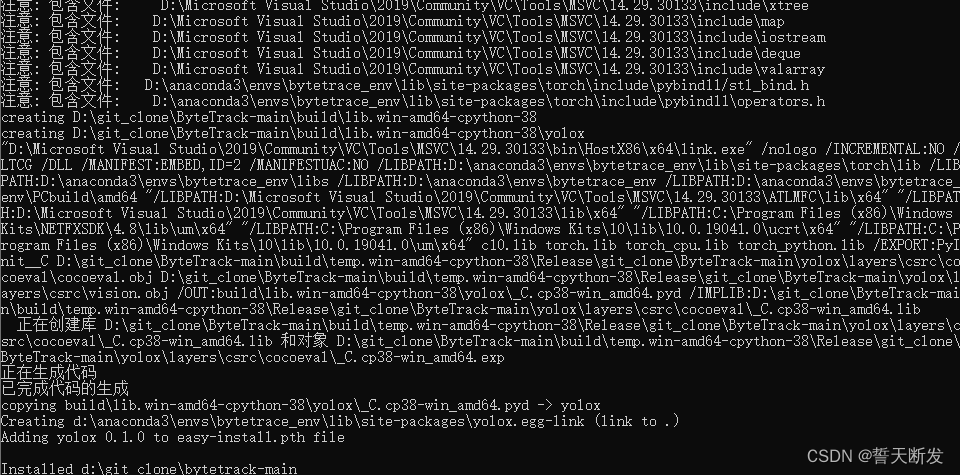
上述即安装成功。
安装pycocotoolspip install cython pip install 'git+https://github.com/cocodataset/cocoapi.git#subdirectory=PythonAPI'或者(Linux)
pip install git+https://gitee.com/pursuit_zhangyu/cocoapi.git#subdirectory=PythonAPIwindows下
pip install pycocotools-windows二、安装tensorrt环境
下载tensorrt包
TensorRT-8.4.3.1.Windows10.x86_64.cuda-10.2.cudnn8.4.zip
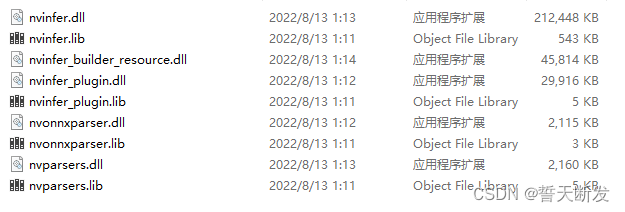
将所有的dll复制到
C:\Program Files\NVIDIA GPU Computing Toolkit\CUDA\v10.0\bin
并设置环境变量。

虚拟环境中python版本为python3.8pip install tensorrt-8.4.3.1-cp38-none-win_amd64.whl三、转换模型
https://pan.baidu.com/s/1PiP1kQfgxAIrnGUbFP6Wfg
qflm
获取bytetrack_s_mot17.pth.tar并创建pretrained进行存放python tools/trt.py -f exps/example/mot/yolox_s_mix_det.py -c pretrained/bytetrack_s_mot17.pth.tar最后在D:\git_clone\ByteTrack-main\YOLOX_outputs\yolox_s_mix_det目录下生成tensorrt模型与pth模型:

四、cmake生成eigen库并使用VS2015编译
https://pan.baidu.com/s/15kEfCxpy-T7tz60msxxExg
ueq4
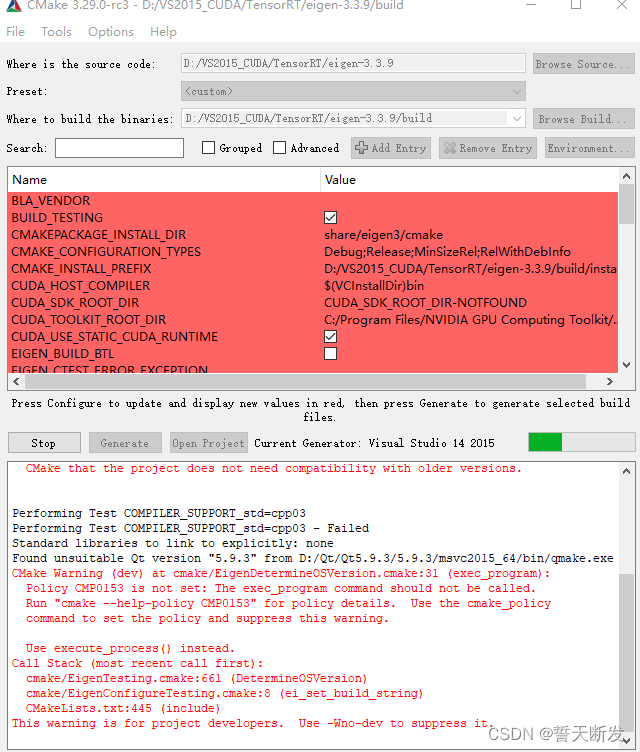
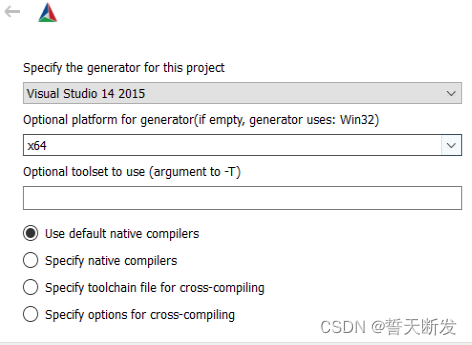

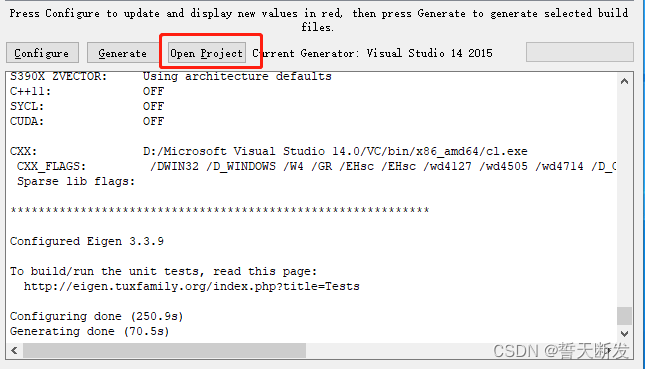
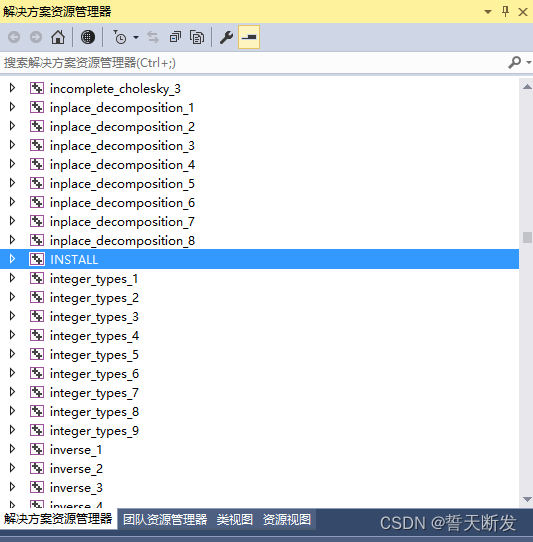
五、下载opencv450
https://nchc.dl.sourceforge.net/project/opencvlibrary/4.5.0/opencv-4.5.0-vc14_vc15.exe?viasf=1
安装D:\opencv450六、cmake生成bytetrack并使用VS2015编译
修改CMakeLists.txt
cmake_minimum_required(VERSION 2.6) project(bytetrack) add_definitions(-std=c++11) option(CUDA_USE_STATIC_CUDA_RUNTIME OFF) set(CMAKE_CXX_STANDARD 11) set(CMAKE_BUILD_TYPE Debug) find_package(CUDA REQUIRED) include_directories(${ PROJECT_SOURCE_DIR}/include) include_directories(D:\VS2015_CUDA\TensorRT\eigen-3.3.9\build\install\include\eigen3) link_directories(${ PROJECT_SOURCE_DIR}/include) # include and link dirs of cuda and tensorrt, you need adapt them if yours are different # cuda include_directories(C:\Program Files\NVIDIA GPU Computing Toolkit\CUDA\v10.0\include) link_directories(C:\Program Files\NVIDIA GPU Computing Toolkit\CUDA\v10.0\lib\x64) # cudnn include_directories(C:\Program Files\NVIDIA GPU Computing Toolkit\CUDA\v10.0\include) link_directories(C:\Program Files\NVIDIA GPU Computing Toolkit\CUDA\v10.0\lib\x64) # tensorrt include_directories(D:\VS2015_CUDA\TensorRT\TensorRT-8.4.3.1\include) link_directories(D:\VS2015_CUDA\TensorRT\TensorRT-8.4.3.1\lib) set(CMAKE_CXX_FLAGS "${CMAKE_CXX_FLAGS} -std=c++11 -Wall -D_MWAITXINTRIN_H_INCLUDED") set(OpenCV_INCLUDE_DIRS_DIRS D:\opencv450\build\include) set(OpenCV_LIBS D:\opencv450\build\x64\vc14\lib) include_directories(${ OpenCV_INCLUDE_DIRS}) file(GLOB My_Source_Files ${ PROJECT_SOURCE_DIR}/src/*.cpp) add_executable(bytetrack ${ My_Source_Files}) target_link_libraries(bytetrack nvinfer) target_link_libraries(bytetrack cudart) target_link_libraries(bytetrack ${ OpenCV_LIBS}) add_definitions(-O2 -pthread)使用CMake进行配置生成。
打开VS2015工程进行配置
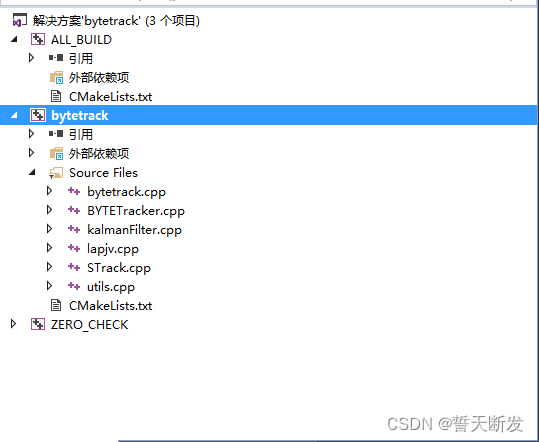
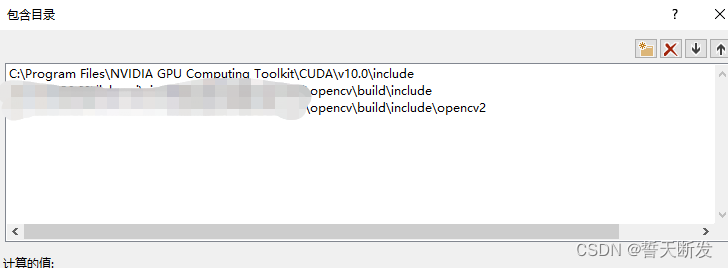

opencv可以自己加进去编译。

修改bytetrack.cppint img_w = cap.get(cv::CAP_PROP_FRAME_WIDTH); int img_h = cap.get(cv::CAP_PROP_FRAME_HEIGHT);这里有个bug,高的参数不对,会影响后面的demo.mp4。
编译生成

七、使用Dependency Walker查看exe依赖
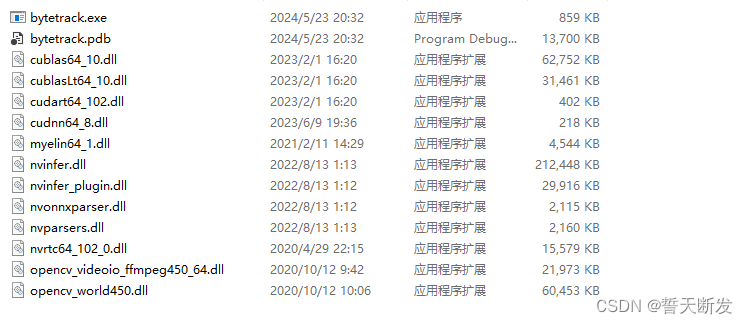
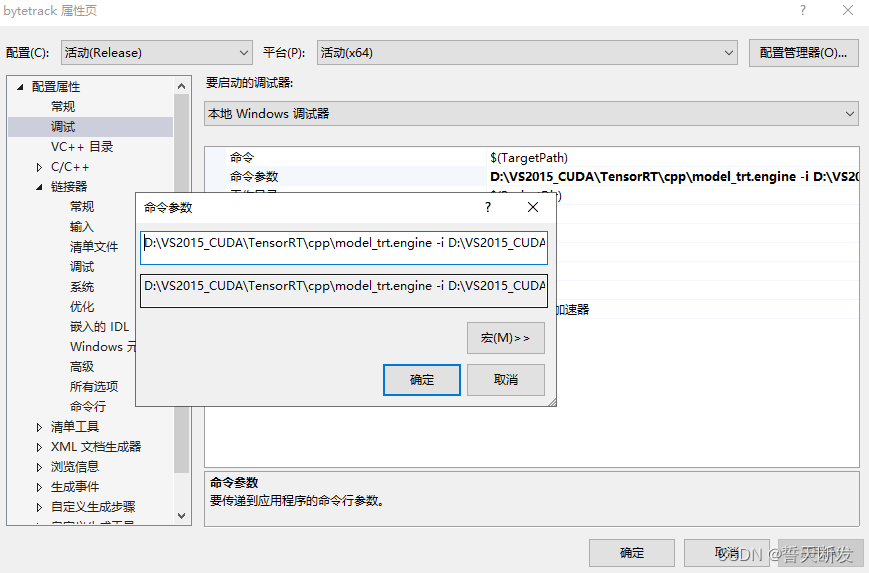
D:\VS2015_CUDA\TensorRT\cpp\model_trt.engine -i D:\VS2015_CUDA\TensorRT\cpp\palace.mp4八、windows源码
bytetrack.cpp
#include#include #include #include #include #include #include #include "NvInfer.h" #include "cuda_runtime_api.h" #include "logging.h" #include "BYTETracker.h" #define CHECK(status) \ do\ { \ auto ret = (status);\ if (ret != 0)\ { \ cerr << "Cuda failure: " << ret << endl;\ abort();\ }\ } while (0) #define DEVICE 0 // GPU id #define NMS_THRESH 0.7 #define BBOX_CONF_THRESH 0.1 using namespace nvinfer1; // stuff we know about the network and the input/output blobs static const int INPUT_W = 1088; static const int INPUT_H = 608; const char* INPUT_BLOB_NAME = "input_0"; const char* OUTPUT_BLOB_NAME = "output_0"; static Logger gLogger; Mat static_resize(Mat& img) { float r = min(INPUT_W / (img.cols*1.0), INPUT_H / (img.rows*1.0)); // r = std::min(r, 1.0f); int unpad_w = r * img.cols; int unpad_h = r * img.rows; Mat re(unpad_h, unpad_w, CV_8UC3); resize(img, re, re.size()); Mat out(INPUT_H, INPUT_W, CV_8UC3, Scalar(114, 114, 114)); re.copyTo(out(Rect(0, 0, re.cols, re.rows))); return out; } struct GridAndStride { int grid0; int grid1; int stride; }; static void generate_grids_and_stride(const int target_w, const int target_h, vector<int>& strides, vector<GridAndStride>& grid_strides) { for (auto stride : strides) { GridAndStride GS; int num_grid_w = target_w / stride; int num_grid_h = target_h / stride; for (int g1 = 0; g1 < num_grid_h; g1++) { for (int g0 = 0; g0 < num_grid_w; g0++) { GS.grid0 = g0; GS.grid1 = g1; GS.stride = stride; grid_strides.push_back(GS); } } } } static inline float intersection_area(const Object& a, const Object& b) { Rect_<float> inter = a.rect & b.rect; return inter.area(); } static void qsort_descent_inplace(vector<Object>& faceobjects, int left, int right) { int i = left; int j = right; float p = faceobjects[(left + right) / 2].prob; while (i <= j) { while (faceobjects[i].prob > p) i++; while (faceobjects[j].prob < p) j--; if (i <= j) { // swap swap(faceobjects[i], faceobjects[j]); i++; j--; } } #pragma omp parallel sections { #pragma omp section { if (left < j) qsort_descent_inplace(faceobjects, left, j); } #pragma omp section { if (i < right) qsort_descent_inplace(faceobjects, i, right); } } } static void qsort_descent_inplace(vector<Object>& objects) { if (objects.empty()) return; qsort_descent_inplace(objects, 0, objects.size() - 1); } static void nms_sorted_bboxes(const vector<Object>& faceobjects, vector<int>& picked, float nms_threshold) { picked.clear(); const int n = faceobjects.size(); vector<float> areas(n); for (int i = 0; i < n; i++) { areas[i] = faceobjects[i].rect.area(); } for (int i = 0; i < n; i++) { const Object& a = faceobjects[i]; int keep = 1; for (int j = 0; j < (int)picked.size(); j++) { const Object& b = faceobjects[picked[j]]; // intersection over union float inter_area = intersection_area(a, b); float union_area = areas[i] + areas[picked[j]] - inter_area; // float IoU = inter_area / union_area if (inter_area / union_area > nms_threshold) keep = 0; } if (keep) picked.push_back(i); } } static void generate_yolox_proposals(vector<GridAndStride> grid_strides, float* feat_blob, float prob_threshold, vector<Object>& objects) { const int num_class = 1; const int num_anchors = grid_strides.size(); for (int anchor_idx = 0; anchor_idx < num_anchors; anchor_idx++) { const int grid0 = grid_strides[anchor_idx].grid0; const int grid1 = grid_strides[anchor_idx].grid1; const int stride = grid_strides[anchor_idx].stride; const int basic_pos = anchor_idx * (num_class + 5); // yolox/models/yolo_head.py decode logic float x_center = (feat_blob[basic_pos+0] + grid0) * stride; float y_center = (feat_blob[basic_pos+1] + grid1) * stride; float w = exp(feat_blob[basic_pos+2]) * stride; float h = exp(feat_blob[basic_pos+3]) * stride; float x0 = x_center - w * 0.5f; float y0 = y_center - h * 0.5f; float box_objectness = feat_blob[basic_pos+4]; for (int class_idx = 0; class_idx < num_class; class_idx++) { float box_cls_score = feat_blob[basic_pos + 5 + class_idx]; float box_prob = box_objectness * box_cls_score; if (box_prob > prob_threshold) { Object obj; obj.rect.x = x0; obj.rect.y = y0; obj.rect.width = w; obj.rect.height = h; obj.label = class_idx; obj.prob = box_prob; objects.push_back(obj); } } // class loop } // point anchor loop } float* blobFromImage(Mat& img){ cvtColor(img, img, COLOR_BGR2RGB); float* blob = new float[img.total()*3]; int channels = 3; int img_h = img.rows; int img_w = img.cols; vector<float> mean = { 0.485f, 0.456f, 0.406f}; vector<float> std = { 0.229f, 0.224f, 0.225f}; for (size_t c = 0; c < channels; c++) { for (size_t h = 0; h < img_h; h++) { for (size_t w = 0; w < img_w; w++) { blob[c * img_w * img_h + h * img_w + w] = (((float)img.at<Vec3b>(h, w)[c]) / 255.0f - mean[c]) / std[c]; } } } return blob; } static void decode_outputs(float* prob, vector<Object>& objects, float scale, const int img_w, const int img_h) { vector<Object> proposals; vector<int> strides = { 8, 16, 32}; vector<GridAndStride> grid_strides; generate_grids_and_stride(INPUT_W, INPUT_H, strides, grid_strides); generate_yolox_proposals(grid_strides, prob, BBOX_CONF_THRESH, proposals); //std::cout << "num of boxes before nms: " << proposals.size() << std::endl; qsort_descent_inplace(proposals); vector<int> picked; nms_sorted_bboxes(proposals, picked, NMS_THRESH); int count = picked.size(); //std::cout << "num of boxes: " << count << std::endl; objects.resize(count); for (int i = 0; i < count; i++) { objects[i] = proposals[picked[i]]; // adjust offset to original unpadded float x0 = (objects[i].rect.x) / scale; float y0 = (objects[i].rect.y) / scale; float x1 = (objects[i].rect.x + objects[i].rect.width) / scale; float y1 = (objects[i].rect.y + objects[i].rect.height) / scale; // clip // x0 = std::max(std::min(x0, (float)(img_w - 1)), 0.f); // y0 = std::max(std::min(y0, (float)(img_h - 1)), 0.f); // x1 = std::max(std::min(x1, (float)(img_w - 1)), 0.f); // y1 = std::max(std::min(y1, (float)(img_h - 1)), 0.f); objects[i].rect.x = x0; objects[i].rect.y = y0; objects[i].rect.width = x1 - x0; objects[i].rect.height = y1 - y0; } } const float color_list[80][3] = { { 0.000, 0.447, 0.741}, { 0.850, 0.325, 0.098}, { 0.929, 0.694, 0.125}, { 0.494, 0.184, 0.556}, { 0.466, 0.674, 0.188}, { 0.301, 0.745, 0.933}, { 0.635, 0.078, 0.184}, { 0.300, 0.300, 0.300}, { 0.600, 0.600, 0.600}, { 1.000, 0.000, 0.000}, { 1.000, 0.500, 0.000}, { 0.749, 0.749, 0.000}, { 0.000, 1.000, 0.000}, { 0.000, 0.000, 1.000}, { 0.667, 0.000, 1.000}, { 0.333, 0.333, 0.000}, { 0.333, 0.667, 0.000}, { 0.333, 1.000, 0.000}, { 0.667, 0.333, 0.000}, { 0.667, 0.667, 0.000}, { 0.667, 1.000, 0.000}, { 1.000, 0.333, 0.000}, { 1.000, 0.667, 0.000}, { 1.000, 1.000, 0.000}, { 0.000, 0.333, 0.500}, { 0.000, 0.667, 0.500}, { 0.000, 1.000, 0.500}, { 0.333, 0.000, 0.500}, { 0.333, 0.333, 0.500}, { 0.333, 0.667, 0.500}, { 0.333, 1.000, 0.500}, { 0.667, 0.000, 0.500}, { 0.667, 0.333, 0.500}, { 0.667, 0.667, 0.500}, { 0.667, 1.000, 0.500}, { 1.000, 0.000, 0.500}, { 1.000, 0.333, 0.500}, { 1.000, 0.667, 0.500}, { 1.000, 1.000, 0.500}, { 0.000, 0.333, 1.000}, { 0.000, 0.667, 1.000}, { 0.000, 1.000, 1.000}, { 0.333, 0.000, 1.000}, { 0.333, 0.333, 1.000}, { 0.333, 0.667, 1.000}, { 0.333, 1.000, 1.000}, { 0.667, 0.000, 1.000}, { 0.667, 0.333, 1.000}, { 0.667, 0.667, 1.000}, { 0.667, 1.000, 1.000}, { 1.000, 0.000, 1.000}, { 1.000, 0.333, 1.000}, { 1.000, 0.667, 1.000}, { 0.333, 0.000, 0.000}, { 0.500, 0.000, 0.000}, { 0.667, 0.000, 0.000}, { 0.833, 0.000, 0.000}, { 1.000, 0.000, 0.000}, { 0.000, 0.167, 0.000}, { 0.000, 0.333, 0.000}, { 0.000, 0.500, 0.000}, { 0.000, 0.667, 0.000}, { 0.000, 0.833, 0.000}, { 0.000, 1.000, 0.000}, { 0.000, 0.000, 0.167}, { 0.000, 0.000, 0.333}, { 0.000, 0.000, 0.500}, { 0.000, 0.000, 0.667}, { 0.000, 0.000, 0.833}, { 0.000, 0.000, 1.000}, { 0.000, 0.000, 0.000}, { 0.143, 0.143, 0.143}, { 0.286, 0.286, 0.286}, { 0.429, 0.429, 0.429}, { 0.571, 0.571, 0.571}, { 0.714, 0.714, 0.714}, { 0.857, 0.857, 0.857}, { 0.000, 0.447, 0.741}, { 0.314, 0.717, 0.741}, { 0.50, 0.5, 0} }; void doInference(IExecutionContext& context, float* input, float* output, const int output_size, Size input_shape) { const ICudaEngine& engine = context.getEngine(); // Pointers to input and output device buffers to pass to engine. // Engine requires exactly IEngine::getNbBindings() number of buffers. assert(engine.getNbBindings() == 2); void* buffers[2]; // In order to bind the buffers, we need to know the names of the input and output tensors. // Note that indices are guaranteed to be less than IEngine::getNbBindings() const int inputIndex = engine.getBindingIndex(INPUT_BLOB_NAME); assert(engine.getBindingDataType(inputIndex) == nvinfer1::DataType::kFLOAT); const int outputIndex = engine.getBindingIndex(OUTPUT_BLOB_NAME); assert(engine.getBindingDataType(outputIndex) == nvinfer1::DataType::kFLOAT); int mBatchSize = engine.getMaxBatchSize(); // Create GPU buffers on device CHECK(cudaMalloc(&buffers[inputIndex], 3 * input_shape.height * input_shape.width * sizeof(float))); CHECK(cudaMalloc(&buffers[outputIndex], output_size*sizeof(float))); // Create stream cudaStream_t stream; CHECK(cudaStreamCreate(&stream)); // DMA input batch data to device, infer on the batch asynchronously, and DMA output back to host CHECK(cudaMemcpyAsync(buffers[inputIndex], input, 3 * input_shape.height * input_shape.width * sizeof(float), cudaMemcpyHostToDevice, stream)); context.enqueue(1, buffers, stream, nullptr); CHECK(cudaMemcpyAsync(output, buffers[outputIndex], output_size * sizeof(float), cudaMemcpyDeviceToHost, stream)); cudaStreamSynchronize(stream); // Release stream and buffers cudaStreamDestroy(stream); CHECK(cudaFree(buffers[inputIndex])); CHECK(cudaFree(buffers[outputIndex])); } int main(int argc, char** argv) { cudaSetDevice(DEVICE); // create a model using the API directly and serialize it to a stream char *trtModelStream{ nullptr}; size_t size{ 0}; if (argc == 4 && string(argv[2]) == "-i") { const string engine_file_path { argv[1]}; ifstream file(engine_file_path, ios::binary); if (file.good()) { file.seekg(0, file.end); size = file.tellg(); file.seekg(0, file.beg); trtModelStream = new char[size]; assert(trtModelStream); file.read(trtModelStream, size); file.close(); } } else { cerr << "arguments not right!" & -
相关阅读:
【不三不四的脑洞】一个梦所引发关于排序算法的思考
CS免杀姿势
python中的字节码对象初探
【日志解析】【启发式】Drain:一种用于日志解析的深度解析树
psd-tools
第二章 Redis高级
TaskDispatcher源码解析
【计网 DNS】计算机网络 DNS协议详解:中科大郑烇老师笔记 (六)
2024龙年特别篇 -- 魔法指针 之 指针变量
六.初阶指针
- 原文地址:https://blog.csdn.net/baidu_28342107/article/details/139152620